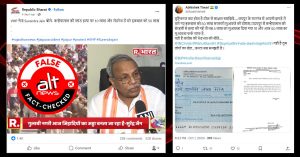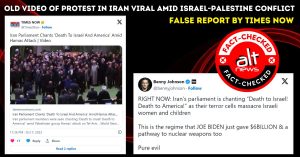When the annual TIME list of 100 most influential people was released in April 2017, it contained both good news and not so good news depending on how you look at it. Like 2015, this year too, Prime Minister Narendra Modi was featured in the list but unlike 2015, the accompanying introductory write-up was not a very flattering one. Every year, for each person who finds a place in the list, TIME invites a known personality to write a few words about him/her. In 2015, US President Barack Obama wrote the introduction for PM Modi. This year the honor was done by the author, Pankaj Mishra who is known to be a vocal critic of Mr. Modi’s brand of politics.
In early 2015, when the TIME 100 list came out, the BJP government had spent less than one year in office. Expectations were high and the mood was one of cautious optimism which Obama captured well in his write-up. It was soon after the Obama’s visit to India where Modi had addressed him as “Barack” to show that the two were on first name basis. In turn, Obama reciprocated the personal touch by referring to Modi as “Narendra” in his write-up.
Now fast forward to 2017. The BJP government has been in power for nearly three years and the initial euphoria has settled down. The write-up can no longer be about promises alone. It is perhaps with this in mind that TIME invited Mishra to write about Modi.
In the introduction to the list, TIME made an important point when they mentioned, “In divisive times, it’s tempting to nestle in a comfort zone, surrounded by people who look like us, think like us, pray like us, vote like us.” Inviting Pankaj Mishra to write about Modi challenged the very heart of this comfort zone and Mishra did not mince his words when he wrote this introduction.
“In May 2014, long before Donald Trump seemed conceivable as a U.S. President, Narendra Modi became the Prime Minister of the world’s largest democracy. Once barred from the U.S. for his suspected complicity in anti-Muslim violence, and politically ostracized at home as well, this Hindu nationalist used Twitter to bypass traditional media and speak directly to masses feeling left or pushed behind by globalization, and he promised to make India great again by rooting out self-serving elites. Nearly three years later, his vision of India’s economic, geopolitical and cultural supremacy is far from being realized, and his extended family of Hindu nationalists have taken to scapegoating secular and liberal intellectuals as well as poor Muslims.
Yet Modi’s aura remains undimmed. He is a maestro of the art of political seduction, playing on the existential fears and cultural insecurities of people facing downward or blocked mobility. In March, he won elections in Uttar Pradesh, India’s most politically significant state, by a landslide—confirmation that elected strongmen are the chief beneficiaries of a global revolt against elites.”
It is interesting to note how Indian media covered PM Modi’s profile while reporting that he featured in the list of 100 most influential people. While some media like Indian Express, Hindustan Times, NDTV, India Today and Economic Times quoted the profile verbatim with only minor edits that didn’t change the overall tone, others were clearly uncomfortable talking about it. A few carried an edited version, omitting details. A few presented excerpts of the 2015 citation instead of the current one. A few others tried to twist the facts to make it seem more favourable. Let us look at a few of them:
Zee News covered the news about Modi in the ‘most influential people list’ but skipped mentioning the introduction that accompanied the listing. Instead they quoted from the 2015 write-up by Obama. They went a step further to add, that the magazine notes that unlike many of his predecessors, PM Modi has worked to lead from the front. “He’s already carved out an impressive international profile — not too many other international leaders can pack Madison Square Garden for a speech, as Modi did last September.” In reality, the magazine had made no such observation about Modi this year. This quote is actually a two year old from 2015 that has been presented in a way that makes it sound like it is part of the 2017 citation. A positive angle has thus been given to the story with details that are not part of it.
Back in 2015, Zee News had covered the story quoting Obama’s introduction of Modi. This is the same introduction that they have repeated in this year’s story, blacking out completely the current year’s write-up.
LiveMint too made the same choice of making no mention of the actual 2017 write-up. “He was named among Time’s 100 most influential people in the world in 2015 and former US President Barack Obama had written a profile for him for the magazine”, says their write-up.
Their coverage of the list this year is in sharp contrast to 2015 where they talked of warm personal friendship between Modi and Obama and went on to share the full write-up.
Times of India After carrying a story about PM Modi being among probables for the list, Times of India’s coverage when the actual list came out was subdued. The story mentioned that PM Modi’s profile was written by Pankaj Mishra but carried only two sentences from it. Only first part of Mishra’s sentence, “Nearly three years later, his vision of India’s economic, geopolitical and cultural supremacy is far from being realized and his extended family of Hindu nationalists have taken to scapegoating secular and liberal intellectuals as well as poor Muslims” was carried and the bit about Hindu nationalists was omitted.
Times Now headline talks about “Prime Minister Narendra Modi and Paytm founder Vijay Shekhar Sharma – the only two Indians to feature on the list” but they were also uncomfortable mentioning the magazine’s citation for Modi. Instead they mention that “in 2015 and former US president Barack Obama had written a profile of him for the magazine”.
The picture gets murkier as we get to Hindi publications.
Jagran clearly misrepresents the reality with a headline saying “ट्रंप, पुतिन और जिनपिंग को पछाड़ TIME में पीएम मोदी का जलवा कायम”. (Defeating Trump, Putin and Jinping, PM continues his stint in TIME) In reality Trump, Putin and Jinping are also part of the list and Modi has not edged them out to make it to the list.
Dainik Bhaskar also follows suit in its coverage of the news. They also take solace in the fact that two years ago Obama wrote about Modi. They then proceed to mention only the first sentence of the 2017 citation and give an incomplete picture of the message by saying “इसमें उन्होंने लिखा है कि जब डोनाल्ड ट्रंप के अमेरिका का राष्ट्रपति बनने के कयास लग रहे थे उससे काफी पहले मई 2014 में मोदी दुनिया के सबसे बड़े लोकतंत्र के प्रधानमंत्री बन गए।“ (When Donald Trump was working hard to become the President of the United States, much before that in May 2014, Modi had already become the Prime Minister of world’s largest democracy). In this one sentence, they summarised Mishra’s sharp criticism by giving it a positive spin.
NamoApp, prime minister’s own app that regularly shares good news is also silent about him being featured in the TIME 100 list. A few months ago when Modi won the TIME ‘person of the year’ reader’s poll, the App had carried the story. This time around there are no congratulatory messages from ministers and no twitter hashtag run by supporters. WhatsApp groups and propaganda sites too are strangely silent.
One can disagree with the profile of PM Modi published in TIME but to black it out completely or to present it in a misleading way says a lot about how some of the media operates. While they fawned over the positive mention in the previous years, any touch of criticism makes them uncomfortable about reporting it. As always, they pick which stories to bring to the readers and which angles to omit. Dear readers, the TIME 100 story, like many others, was suitably sanitized by some of the media for your reading pleasure.
Independent journalism that speaks truth to power and is free of corporate and political control is possible only when people start contributing towards the same. Please consider donating towards this endeavour to fight fake news and misinformation.




